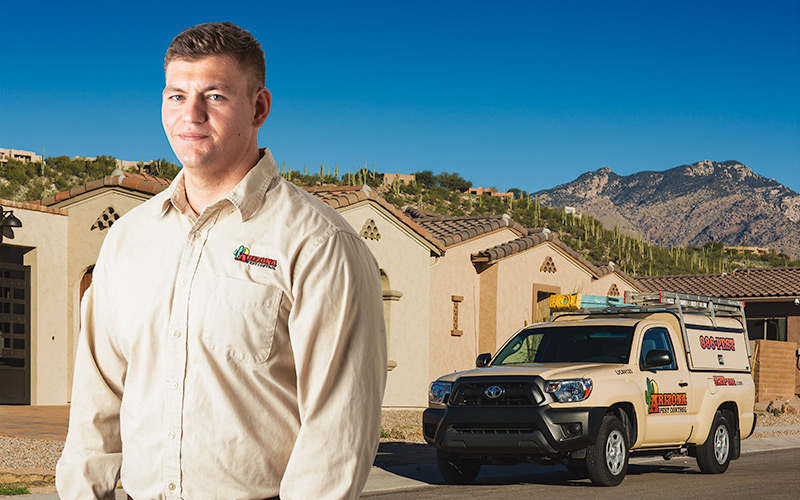Southern Arizona homeowners know the beauty and unique charm of the desert, but they also understand the challenges that come with living in termite territory. Termites thrive in the warm, dry climate and can wreak havoc on your property before you even realize what’s happening.
The sooner you identify an infestation, the better you can protect your investment. This guide will walk you through the most common warning signs of termites in Southern Arizona and provide actionable tips to safeguard your home.
Why Termites Are a Concern in Southern Arizona
Southern Arizona’s climate is ideal for several species of termites, particularly subterranean termites. These pests thrive in the region’s heat and dry conditions, often going unnoticed until significant damage occurs to wooden structures. Homeowners often underestimate the severity of termite infestations because these silent destroyers work within walls, floors, and foundations for years before they’re detected.
Understanding the warning signs allows you to take proactive measures to protect your home and avoid costly repairs.
The 7 Warning Signs of Termites
1. Mud Tubes on Walls or Foundations
Subterranean termites build mud tubes to travel between their nests and food sources. These pencil-width trails are made from soil, saliva, and wood particles and are typically seen on foundations, walls, or crawl spaces. The tubes protect termites from predators and maintain the moisture they need to survive.
Tip: Break open a mud tube. If termites are inside, you likely have an active infestation.
2. Discarded Wings Near Doors and Windows
Termite swarms often occur during the warmer months. After mating, flying termites (also known as swarmers) shed their wings before burrowing to create new colonies. Finding piles of wings near doors, windows, or other entry points is a strong indicator of termite activity.
Tip: Keep a flashlight handy to inspect corners or darker spaces near entry points where wings might accumulate.
3. Hollow or Damaged Wood
One of the most distinct signs of termites is wood that sounds hollow when tapped. Termites consume wood from the inside out, sometimes leaving only a thin outer layer intact. You may notice blistering, splintering, or sagging wood in walls, floors, or ceilings.
Tip: Use a screwdriver to gently probe wood around your home. If it easily punctures the surface, termites might be present.
4. Visible Frass or Droppings
Termite droppings, also known as frass, resemble tiny wood pellets or grains of sand. Drywood termites, in particular, leave piles of frass near their entry points or galleries. These droppings are signs that termites are actively feeding inside your home.
Tip: Check window sills, baseboards, and other undisturbed areas for small piles of frass.
5. Cracked or Bubbling Paint
Wall paint that appears bubbled or cracked might indicate termite activity beneath the surface. Termites create moisture as they digest wood, which can cause paint to peel or blister.
Tip: Look for cracked or uneven paint around areas with wood, such as window sills, door frames, or baseboards.
6. Swarmers Indoors
Spotting flying termites inside your home is a clear warning sign of an active infestation. These swarmers are often mistaken for flying ants, but termites have straight antennae, a broad waist, and equal-length wings, making them distinct from their ant counterparts.
Tip: If you spot swarmers in your home, capture a sample (dead or alive) to confirm whether it’s termites or ants.
7. Tight or Hard-to-Open Doors and Windows
Termite activity can damage wood, causing it to warp or swell due to moisture. This often results in doors and windows that stick or are unusually difficult to open.
Tip: If only one or two doors persistently stick while others are fine, termites might be the culprit.
Steps to Protect Your Home From Termites
Detecting an infestation early is crucial in limiting the damage termites can cause. Here are some proactive measures to keep your home protected year-round in Southern Arizona:
1. Seek Regular Inspections
Schedule professional termite inspections at least once a year. Experts are trained to identify warning signs that may not be immediately visible.
2. Reduce Moisture
Fix leaky pipes, clean gutters, and eliminate standing water around your property to make your home less inviting to termites. Moisture is one of their primary needs.
3. Seal Entry Points
Seal cracks in foundations and gaps around utility lines to limit access. Check that your home’s weather stripping and caulking are in good condition.
4. Maintain Proper Landscaping
Ensure shrubs and trees are trimmed and not too close to your home’s walls. Keep mulch and firewood stored at least 18 inches away from the foundation.
Professional Termite Services in Southern Arizona
If you’re noticing any of the warning signs listed above, don’t wait to take action. A trusted pest control professional can provide a thorough inspection and recommend treatment options to ensure peace of mind. Many companies offer free inspections and treatment plans tailored to Southern Arizona’s unique climate and termite species.
Consider scheduling your inspection today to prevent termites from putting your home at risk.
Taking Action Against Termites
Termites can be devastating to homeowners in Southern Arizona, but recognizing the signs early can save you thousands of dollars in repairs. By being proactive, monitoring the warning signs, and keeping up with professional inspections, you can protect your property and ensure it remains termite-free for years to come.
Got termite concerns? Schedule your free termite inspection with us and take the first step toward peace of mind.











